College Algebra & Pre-Calculus
with the TI-89 Calculator
Basic Preliminary Operations
Before you can begin to use your calculator for algebra and mathematics, you must first find a few basic keys and know how to use them.
Power Keys
There are three main power keys; the 'exponential' keys, the 'ten to the power' keys, and the 'raise to the power' key. Here's how they work.
Exponential - eˣ
The exponential constant e is actually an irrational number that has the value of about 2.718. You can find this button on the X key. To perform e computations, press  and then eˣ[X]. Let's square the value of e by pressing
and then eˣ[X]. Let's square the value of e by pressing  , X, 2, ), Enter. The value of e² appears on your screen. (To make sure it's in decimal format, and not fraction format, you need to press MODE, scroll down to option Exact/Approx and ensure that it is set to Approximate.)
, X, 2, ), Enter. The value of e² appears on your screen. (To make sure it's in decimal format, and not fraction format, you need to press MODE, scroll down to option Exact/Approx and ensure that it is set to Approximate.)
Scientific Notation - EE
Another extremely important power button is the 'ten to the power' key. To calculate a number like 5x10², all you have to do is press 5, EE, 2, ENTER. You find that 5x10² = 500. This method is known as scientific notation, and you will probably use this key thousands of times in the future.
Raise and number to a power
To raise any number to power, simply enter the number and use the ^ key. For example, to solve for 2³, press 2, ^, 3, ENTER. The result is that 2³ = 8.
Keys for Variables
Often you need to make long calculations with many variables. Keeping track of variables can be time consuming. Also, you often have the same exact data values that need to be plugged into an equation many times. By using variables, you can save lots of time not having to enter the same information in, over and over again. This also leads to increased accuracy. Since a number is only entered once, the probability that you have entered the wrong data for one or more of your calculations is decreased.
The TI-89 calculator has four global variable buttons, X, Y, Z, and T. They are located close to the center of your keypad. Let's enter the number 5 into the variable X. Press 5, STO→, X, ENTER. The number 5 is now stored in X for immediate retrieval. Press X, ENTER and you can now substitute X into all of your equations that use this variable. For instance, 2X is now 10.
A slightly more difficult method of using variables is to put them into the other letter variables which are denoted in purple on your calculator above the keys. To enter the number 4.5 into variable L, press 4.5, STO→, alpha, 4, ENTER. The valve 4.5 is now stored in L. You can see that this process is more time consuming, so for quick access, with only a few variables, just use X, Y, Z, T. Note also that you can now multiply variables such as XL.
Graphing Equations
Plotting graphs on the TI-89 is also straightforward. Let's start by graphing the equation 2X²+2. We start by entering this formula differently than if we just wanted to calculate the equation by itself. Press  , F1, and then enter the equation 2X²+2 into Y1 as shown on the screenshot. , F1, and then enter the equation 2X²+2 into Y1 as shown on the screenshot. | |
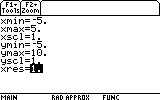 | Now press  and F3. The graph appears on the screen, but it might not be centered symmetrically. To center the graph the way you want it, press and F3. The graph appears on the screen, but it might not be centered symmetrically. To center the graph the way you want it, press  and F2, and then enter the coordinates the way you want them. For this example, enter the coordinates as they appear in the screenshot. and F2, and then enter the coordinates the way you want them. For this example, enter the coordinates as they appear in the screenshot. |
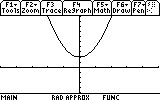 | ← The graph should look like that. |
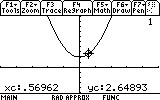 | You can now actually trace the exact coordinates of this function by pressing F3 and observing the coordinates at the bottom of the screen as shown in the screenshot. Simply move your cursor to the left and right, then observe how the numbers change that the bottom of your screen. |
Sequences and Series
Next we will find the first three numbers (the first three terms of the sequence) for an equation. You first need to specify the equation and then decide how many terms you want, and how you want to increment the sequence.
For example, take the sequence an=2+3(n-1). To find the first three terms of this sequence starting at 1, ending at 3, and incrementing by 1 you would enter:
Seq(2+3(X-1),X,1,3,1)
(To find the Seq( function, press 2nd, 5, 3, 1).
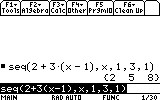 | The first three terms of the sequence are displayed as {2 5 8}. |
To validate these results, calculate the numbers manually. Press 2+3(1-1) and then ENTER. The first term is 2. Now to manually calculate the other two terms more quickly, simply use the left and right arrows to edit the terms you calculated. This should save you a lot of time in the future!
Now, let's sum up all of the terms in sequence. This will come in Very handy as you take more classes that have mathematics in them, like calculus, statistics, and many other classes. Find the sum( function by pressing 2nd, 5, 3, 6. Now enter the information to make it look like this: sum(seq(2+3(x-1),X,1,3,1)). The answer is 15 (which is 2+5+8).
This gives the same result as the summation formula 
If you ever want to find a TI-89 function and you forgot where it is located, press CATALOG. A list of the entire set of TI-89 commands comes onto the screen. To quickly find the Seq( function, press 3 instead of scrolling through the entire list.
|
| 2x |
The first four terms are: 2^1=2; 2^2=4; 2^3=8; 2^4=16; ...
To sum them up, enter the following equation: sum(seq(2ˣ,X,1,20,1). After 20 years, you will have $2,097,150!
Exponents and Polynomials
Exponents are used to write the products of repeating factors. For example, the product of 4x4x4x4x4x4 can more easily be expressed as 4^6. A polynomial is a finite sum of terms in which all variables have whole number exponents and no variables appear in denominators. A polynomial is made up of more than one term. For example, 4X² and 4X²+2X+1 are both polynomials. A coefficient of a term is the number in the term, so the coefficient of 4X² is 4, and the coefficient of 2X is 2.
Greatest Common Factor
The greatest common factor (also known as the greatest common divisor) is the largest integer that will divide into a given list of integers. The greatest common divisor of two positive integers is the largest integer that divides them both.
Find the greatest common factor for the equation 9X²+12X³. The largest number that divides into bother 9 and 12 is 3:
We can use our calculator to achieve this same result by selecting 2nd, 5, 1, alpha, ), 9, 12, ), ENTER.
Least Common Multiple
The least common multiple (also known as the least common denominator) of two positive integers is the smallest integer that is a multiple of both.
Find the least common multiple for the two polynomials 5XY² and 2X³Y. The least common multiple is an expression that is divisible by both 5XY² and 2X³Y. The least common multiple must contain a factor of (5)(2)=10 that is divisible by both 5 and 2. (It must also contain a factor of X³ and Y²).
We can use our calculator to achieve this same result by selecting 2nd, 5, 1, alpha, (, 5, 2, ), ENTER. The result is 10. The least common multiple is therefore:
Expanding a Polynomial
An extremely powerful set of TI-89 algebraic functions is the expand and factor functions. for example, suppose we want to expand the expression (x+1)². Doing this by hand using the FOIL methond is quite simple:
You can imagine that higher order and more complicated expressions can become quite tedious and labor intensive. Your TI-89 has a built-in function to perform these operations for you automatically, but you first need to clear the variables like X so that they can be used for algebraic manipulations. To clear the variables, press 2nd, F1, 1, ENTER, ENTER. Now your calculator is ready to handle the example above.
Let's expand (x+1)². Press F2, 3, and enter the formula shown in the screenshot below:

An equally powerful function is the factor function. In fact, factor and expand perform opposite operations. Let's now take the expanded equation from the example above and factor it. Press F2, 2 and enter the formula shown in the screenshot below:
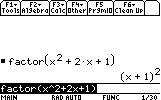
And yet another equally powerful capability is the ability to reduce expressions. This is accomplished via the propFrac function. Let's reduce the following expressing:

The propFrac function can be found in the same place as the last two functions we have worked with. Select F2, 7 and enter the following formula:
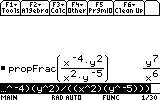
Tables are great for observing your polynomial data at different points. Lets create a table to evaluate the function Y=2X+2. Press  , F1, and then enter the equation 2X+2 on the y1 line.
, F1, and then enter the equation 2X+2 on the y1 line.

Next, press  , F4 and set the parameters of the table to evaluate the function starting from X=-5 and incrementing by 1, and ENTER. Now, simply press
, F4 and set the parameters of the table to evaluate the function starting from X=-5 and incrementing by 1, and ENTER. Now, simply press  , F5 and your table appears, starting with X=-5 and counting indefinitely.
, F5 and your table appears, starting with X=-5 and counting indefinitely.


A complex number is any number that takes the form of a+bi, where a and b are real numbers, i is the square root of -1, and i²=-1. i is also called an imaginary number.
Multiplying imaginary numbers can be tedious. We can use the old FOIL method (First, Outer, Inner, Last), or we can use our calculator to get immediate results.
Find the product of 3+5i and 4-2i:
We can use our calculator to more easily achieve this same result by entering the expression (3+5i)(4-2i) directly. (To find the i button, press 2nd and CATALOG.)
The input and results are shown on the screenshot below:
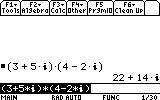
Converting to Fractions
Your calculator can also convert to fractions. This function is hugely popular with students at all levels. Let's divide a complex expression, and then convert it back to its reduced fraction.
Divide (4-3i)/(5+2i). Enter this expression into your calculator like you did before, and press ENTER. The answer you get on your calculator is very hard to read. If you followed the process earlier where we chose our answers to be given in decimal format (to make sure it's in decimal format and not fraction format, you need to select MODE, scroll to Exact/Approx, and select Approximate), your answer requires you to scroll to the right to get the long expression: .4827586207-.7931034483i.
Your calculator can take any ugly number or expression like this and immediately convert it to a fraction. To convert future operations of this type of fractions, select MODE, Exact/Approx, Auto.
The reduced expression is automatically converted into the fraction 14/29-23/29i. Of course, the number does not have to be complex to a fraction. You can perform this operation with any decimal number.
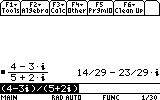
Systems of equations
The idea behind systems of equations is to find solutions that make two or more equations true at the same time. Solve the following system of equations:
X+7Y-3Z=-14
2X-3Y+2Z= 3
Solving systems of equations on the TI-89 is perhaps easier than on any other calculator. Press F2, 1, and then enter the data shown below:
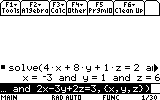
The values that solve all 3 equations simultaneously are:
Finding the roots of equations
Suppose we want to solve the equation:
To solve this equation manually, use factoring to come up with:
This problem is simple, but for higher order polynomials with more terms, this technique will probably not be very efficient at all. To easily solve this problem on the TI-89, we can use the solve( function again. The syntax is as follows:
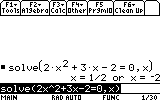
Using Logarithms to solve problems
A common need in algebra as well as many other branches of mathematics is to determine what power a number needs to be raised to in order to obtain a specific outcome. For example, consider the equation:
This is an extremely simple problem, so you might be able to guess the value for X by trial and error. But for more complicated equations, you will want to use a cool little trick that is often not taught in algebra or pre-calculus classes. Here's the formula:
For any equation ax=b, x can be solved directly using the formula:Therefore, for the equation 2x=8, we can solve for X directly by:
Graph the function
To graph 2x we proceed as we did in the earlier section Graphing Equations. Press  , F1, and then enter the equation 2x into Y1. Press
, F1, and then enter the equation 2x into Y1. Press  , F5. You may notice that most of the graph is cut off and you can't see much.
, F5. You may notice that most of the graph is cut off and you can't see much.
Now lets use another trick to quickly format the graph. Press F2, A:ZoomFit, ENTER. You will now notice that the curvature of the graph is nicely shown and you get a much better feel for how the graph looks.
Trace the curve
To trace the function at any value, press F3 and move the cursor along the curve as we did before.
Trigonometric Functions
When graphing trigonometric functions, it is common to graph using the radian mode. to switch your calculator from degrees to radian, press MODE, Angle, Radian, ENTER. Your calculator is now set to radian mode. (To leave this screen, press 2nd and ESC.)
Secant, Cosecant, and Cotangent
Secant, Cosecant, and Cotangent are not built in to the TI-89, so you will have to put the expression in rational form to evaluate. For example, to evaluate csc(4.5), you need to enter 1/sin(4.5).
Solving Equations
Let's find the intersection of calues for X on the interval of 0≤X≤2π for the equation cos(X)=0.5. Assuming your calculator is still set to Radian mode (from the example above), enter cos(x) for y1 and 0.5 for y2, and press  and GRAPH. The graphs of both functions - along with their intersections - appears. If your graph doesn't clearly show both functions, then press F2, then 7 to have your calculator format the axis for you automatically.
and GRAPH. The graphs of both functions - along with their intersections - appears. If your graph doesn't clearly show both functions, then press F2, then 7 to have your calculator format the axis for you automatically.
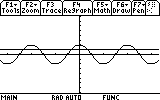
To find the exact intersections of the two graphs, just take it one step further and press F3, and then trace the function. The exact coordinates are traced out.
Polar and Parametric Equations
To graph polar equations, we need to go back to MODE and select Graph -> Polar. Next, the equation must be entered into Y1. (Notice when you enter the equation, r1 appears instead of Y1.) Enter the equation as in the previous examples and you will quickly find that you can also graph polar equations. This exact same process is used for graphing parametric equations.